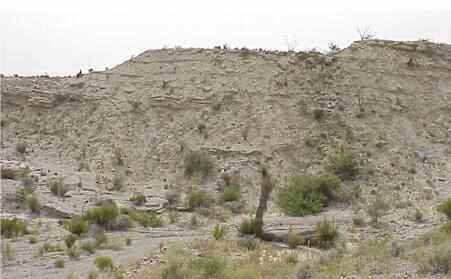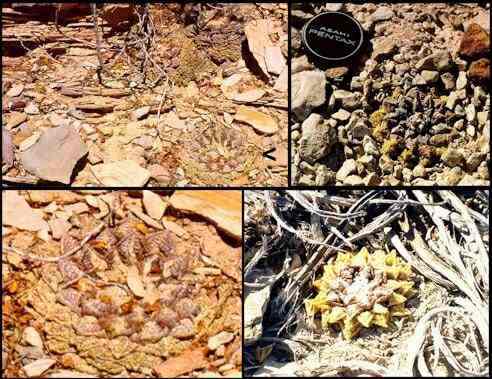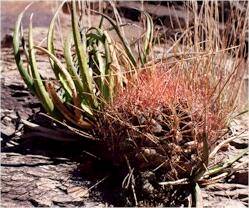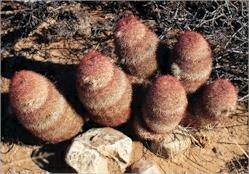CHIHUAHUAN DESERT CACTI
The Chihuahuan Desert does
not have the large, spectacular, columnar cacti
associated with the Sonoran Desert, such as the saguaro,
cardon, organ pipe and senita. But it has many small
cacti and interesting cacti that are found nowhere else
in the world.
Perhaps the best known
example is the peyote (Lophophora williamsii)
which has a long tuberous root and only a small part of
the plant is seen above ground - as a greyish button.
This cactus was once common but is now rare because the
plants have been harvested and sold for their
hallucinogenic properties. It has been almost eliminated
from the small region of Texas where it once occurred -
the extremely dry limestone ledges and hills (see image
below) of the Big Bend National Park. But small
populations still remain in northern Mexico.

Limestone ridge, Big Bend National Monument, Texas
Living
rock cactus
The living rock cactus (Ariocarpus
fissuratus) is an equally strange plant, with a
large, turnip-like taproot. Its above-ground part
consists of a rosette of triangular tubercles which have
no spines and which blend in with the stones and rocks on
the limestone ledges. The compound image below shows some
examples, all photographed in the type of environment
shown above.
Click on
different parts of this image to see larger versions

Ariocarpus fissuratus
is the only species of this genus that occurs in the USA,
although five other species of Ariocarpus are
found in the Chihuahuan Desert of mainland Mexico. All
are protected plants in the regions where they occur.
Many exist as only small, isolated populations and are in
danger of extinction because they sought by plant
collectors.
The thick taproot serves
for water storage. The above-ground part consists of
triangular, warty, spineless tubercles that are
camouflaged remarkably well against the limestone
chippings among which they grow. In times of severe
drought the whole above-ground portion can shrink and be
covered, but the taproot remains alive. These plants
often have a woolly centre, from which bright pink-violet
flowers emerge in autumn.
Boke's
button cactus
The Boke's button (Epithelantha
bokei) is also known as the smooth button. In times
when water is available it is an almost completely
rounded cactus, with small tubercles that are completely
obscured by the very dense coating of tiny white spines.
In times of extreme drought it shrinks into a
concertina-like form (see images below). These specimens
were photographed close to the living rock cacti on a
limestone outcrop.
Eagle claws (or Turk's head) cactus
The eagle claws cactus (Echinocactus
horizonthalonius) is is a small barrel cactus,
usually rounded in form and reaching a diameter of about
15 cm. It is quite common on limestone or lime-rich soils
of parts of West Texas, New Mexico and in the Chihuahuan
Desert of Mexico. There is also an isolated population in
a limestone area of Arizona, where it can grow in a
columnar form, up to 30 cm tall.
As shown in
the left-side image above, this cactus is
characteristically grey-green in colour, with a small
number of broad ribs and deep grooves between them. The
ribs are covered with stout red spines that curve like an
eagle's claw. The image on the right side above shows a
variant or a related species.
Cat
claw cactus

The cat claw cactus (Ancistrocactus
uncinatus) is a small barrel-shaped plant, about 15
cm tall, with ribs composed of fused tubercles. It is
found on limestone soils in the Chihuahuan Desert of
southeastern New Mexico, sothwest Texas and Mexico. The
body of the plant has a bluish colour but the most
conspicuous feature is the combination of long
red-coloured spines, often hooked at their tips, and long
straw-coloured spines. All these main spines project far
above the top of the plant. In this image the cactus is
seen growing next to lechuguilla (a characteristic
Chihuahuan Desert species of Agave with sharp,
banana-shaped leaves) rooted into a crack in a limestone
rock.
Rainbow
cactus

The Texas rainbow (Echinocereus
pectinatus) is one of several rainbow cacti that
have ribbed stems (not tubercles) with very closely
spaced areoles. The spines from these areoles often
almost completely cover the stem, providing protection
from intense sun. As the plants grow from the top of the
stem the spines that they produce in different years or
different times of the year can have different colours.
This results in a banded pattern of spine colours - hence
the name "rainbow" cactus.
There are several types of
rainbow cactus in different desert regions, but the Texas
rainbow is common in the Chihuahuan Desert of Mexico and
in restricted regions of southern New Mexico and Texas.
Hedgehog
cacti (Echinocereus
species)
There are many species and
varieties of hedgehog cacti, all belonging to the genus Echinocereus.
They typically produce clusters of erect stems, up to 30
cm high. The ribs that run up the stems have areoles that
produce long, sharp spines, which stick out like the
spines of a hedgehog. Most of these cacti produce bright,
showy flowers from short flowering branches that emerge
behind the growing tip of the stem.
The individual species are difficult to
tell apart because they hybridise. The most widespread
species is the claret cup (Echinocereus
triglochidiatus), which is variable but always
recognisable by its bright red flowers with rounded petal
margins. This species occurs mainly in upland and
mountain zones rather than in the deserts. In contrast ,
Engelmann's hedgehog (Echinocereus engelmannii)
is a true desert dweller, being found mainly in
south-central Arizona and westwards into southern
California. Several other types of hedgehog cactus are
found in the Chihuahuan Desert.
Several other hedgehog-type cacti occur
in the Chihuahuan Desert, such as the two examples below,
both of which are growing in arid conditions on limestone
substrates. In the left-side image the cactus is growing
alongside lechuguilla - a drought-tolerant species of Agave,
characteristic of the Chihuahuan Desert. In the
right-hand image the neighbouring plant is different,
even though it might look like lechuguilla. Its leaves
have a red colour and rows of spines along the leaf
margins. This plant is the drought-tolerant Hechtia
texensis - a member of the pineapple family.
Go
to Cactus gallery?
Go to
Chihuahuan Desert main page?
|